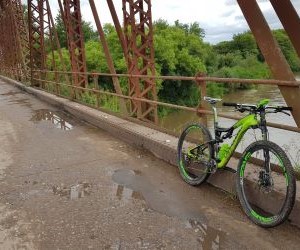Learn how to deal with punctures on long rides with prevention tips, repair techniques, and smart gear choices to keep rolling without stress.
HOW DO I HANDLE DESCENTS ON STEEP HILLS?
Descending steep hills can be thrilling—but also intimidating if your technique isn’t dialed in. A lack of control, poor braking habits, or tense posture can quickly turn fun into fear. This guide breaks down how to handle descents safely and confidently. You’ll learn the fundamentals of bike control, how to use your brakes effectively, the right body position for stability, and mental strategies to stay relaxed. Whether you're tackling mountain switchbacks or rolling country roads, these skills will help you descend like a pro.

Control through braking and speed management
The foundation of a safe descent is knowing how to control your speed without panic or over-braking. Misusing your brakes—especially on steep gradients—can lead to skidding, overheating rims, or total loss of control.
Brake smart, not hard
Always brake before corners, not during. Apply both brakes smoothly and progressively. The front brake provides the most stopping power, but should be used carefully—especially on wet roads. Feather the rear brake to fine-tune speed. On long descents, alternate braking to avoid heat buildup in rims or rotors.
Keep your speed in check early. It’s easier to add speed gradually than to scrub it off in panic. In technical descents, it’s safer to brake in short pulses rather than holding them continuously, which can lead to fade.
Brake before corners, not during
Use the front brake for power, rear for control
Feather your brakes—don’t grab them suddenly
Check brakes and pads before every descent
Descend in the drops for better control and access to brakes
Mastering your brakes is the first step to descending with confidence. The goal is smooth, controlled deceleration—not sudden stops.
Body position for stability and control
Your body acts as a counterbalance and stabilizer during descents. Proper posture improves traction, reduces wind resistance, and gives you greater control over your bike—especially on steep or twisty terrain.
Low and centered is key
Get into the drops on your handlebars to lower your center of gravity and increase brake leverage. Keep your arms slightly bent and relaxed to absorb road vibrations. Move your weight back slightly, especially on very steep pitches, to prevent going over the front.
Keep your knees in toward the top tube and your feet level. This creates a stable platform and helps manage balance in tight corners or crosswinds. Look ahead—not down—to anticipate curves and changes in road conditions.
Ride in the drops for a low, aerodynamic posture
Keep weight slightly rearward on steep slopes
Bend arms and knees to absorb bumps
Look through turns to where you want to go
Stay loose—not stiff—to allow fluid bike movement
Positioning isn’t just about going fast—it’s about staying safe, especially when traction is limited or visibility is low. Practice posture drills on gentle hills to make these adjustments automatic.
Confidence, line choice, and advanced tips
Once you have braking and posture under control, the next step is refining your technique to descend with confidence and speed. This means reading the road, choosing smart lines, and staying mentally calm under pressure.
Flow over fear
Pick smooth lines that avoid potholes, gravel, and road seams. Enter corners wide, cut toward the apex, and exit wide—this classic “outside-inside-outside” approach minimizes lean angle and maintains momentum. Avoid braking mid-corner, as it can destabilize your tires and shift weight unexpectedly.
Confidence grows with repetition. Practice descents regularly in controlled environments. Use each ride to work on one element—posture, braking timing, or line choice. Stay relaxed, breathe deeply, and trust your skills.
Advanced riders may also shift their weight dynamically through corners, use countersteering, or drop their outside foot to increase traction. These skills take time but pay off in smoother, faster descents with less fatigue.
Use the “outside-inside-outside” cornering line
Avoid looking down—focus on the exit
Breathe and relax your grip on the bars
Practice on medium hills before attempting steep descents
Ride with experienced cyclists to learn by observation
Descending is part physics, part psychology. The more you practice with intent, the more second nature it becomes. Respect the gradient, but don’t fear it—master it.
YOU MAY ALSO BE INTERESTED






